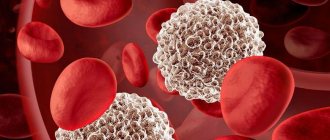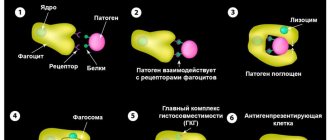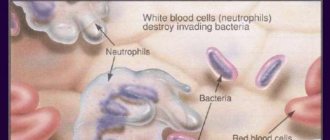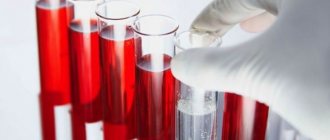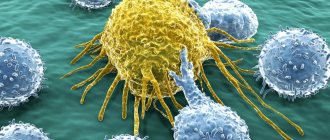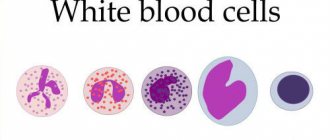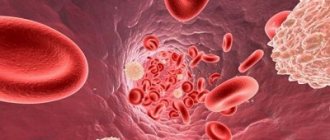Classification
Neutrophil leukocytes themselves come in two main types: segmented (mature) and band (young). Band neutrophils normally make up from 1 to 5% of the total number of leukocytes, segmented neutrophils - from 35 to 65%. Based on the ratio of young and mature cells, neutrophilia are distinguished with and without nuclear shift. A nuclear shift to the left implies an increase in the number of young forms of neutrophils and is divided into the following types:
- Hyporegenerative. A slight increase in band neutrophil leukocytes. The cause is infectious, inflammatory diseases with a mild course.
- Regenerative. It is characterized by the appearance of metamyelocytes in the blood (intermediate forms between myeloblastic cells and granulocytes). Occurs during infections with moderate severity (typhoid fever, pneumonia).
- Hyper-regenerative. Severe hyperactivation of the bone marrow granulocyte lineage with impaired granulocyte maturation. In the blood, the number of band neutrophils, metamyelocytes, promyelocytes is sharply increased, and sometimes myeloblasts are present. Possible aneosinophilia (complete absence of eosinophils). This form of neutrophilia is observed at the very beginning of purulent-inflammatory processes (sepsis, abscesses, phlegmon).
- Degenerative. Along with the increased number of band leukocytes, a large number of destructively altered segmented neutrophils (toxic granularity, pyknosis of nuclei) appear in the blood. Indicates inhibition of the functional activity of the bone marrow. Characteristic of the height of severe infections.
With neutrophilia, which has a nuclear shift to the right, the hemogram shows the absence of young forms of granulocytes and the appearance of hypersegmented (containing more than 5 segments) neutrophils. Neutrophilia without nuclear shift is accompanied by an increase in only segmented neutrophils. In relation to other types of leukocytes, the following are distinguished:
- Relative neutrophilia. An increase in the percentage of neutrophils (in adults more than 75%, in children under 5 years of age - more than 55%) in the leukocyte formula, the total number of leukocytes is normal.
- Absolute neutrophilia. An increase in the number of neutrophils while simultaneously increasing the level of leukocytes.
Types of neutrophilia depending on the degree of nuclear shift in the leukocyte formula
To make the correct diagnosis and prescribe treatment, it is important to take into account the degree of nuclear shift in the leukocyte formula:
- There is no nuclear shift. At the same time, the number of mature segmented nuclear neutrophils in the blood increases and general leukocytosis is diagnosed. A similar situation occurs after a hearty lunch, after physical exertion, during bleeding, or against the background of a mild infectious disease.
- Nuclear shift to the left. Neutrophilia is characterized by an increase in the number of polymorphonuclear neutrophils and a slight increase in myelocytes. A similar blood picture is characteristic of pneumonia, scarlet fever, diphtheria and typhoid.
- Neutrophilia is accompanied by a significant jump in the level of myelocytes. This will indicate a severe infection or purulent-septic inflammation.
- Neutrophilia with deregenerative nuclear shift. In this case, modified neutrophils appear in the blood, which signals severe infections and intoxications of the body, or indicates damage to the bone marrow.
- Neutrophilia with nuclear shifts to the left. Neutrophils with more than 5 segments are present in the blood. Sometimes they are found in healthy people, and sometimes they are a sign of Addison-Birmer anemia.
Causes of neutrophilia
Physiological reasons
There is a so-called physiological neutrophilia, or pseudoneutrophilosis. Its occurrence is not associated with increased neutrophil production, but with their redistribution, i.e. a change in the ratio of the parietal and circulating pools of neutrophils towards the latter. Pseudoneutrophilia is observed under stress, intense physical activity, exposure to heat or cold, and after eating. Also, neutrophils are often increased during pregnancy and in a newborn child.
Infections in children
Due to a physiological decrease in the level of neutrophils due to leukocyte crossover, a child of preschool age (up to 5-6 years) has an increased susceptibility to bacterial infections. In children, neutrophils increase mainly with scarlet fever and streptococcal sore throat. A dangerous infection such as diphtheria is quite common in the pediatric population. Parasitic infestations (ascariasis, enterobiasis, toxocariasis) are also common among preschoolers. In these diseases, in addition to neutrophilia, high eosinophilia is observed in the blood.
Infections in adults
Most often, neutrophils are increased during bacterial infections. The main function of neutrophils is anti-infective protection of the macroorganism, namely, the destruction of bacteria. They also take part in the fight against viruses and parasites. Migrating through the vascular wall, neutrophils are directed to the site of localization of the pathogenic microorganism. By releasing cytokines and inflammatory mediators, neutrophils activate other components of the immune system (complement, T-B lymphocytes).
Neutrophil leukocytes first phagocytize (absorb) the infectious agent, then secrete degradation enzymes (lysozyme, lactoferrin, phosphatases) and reactive oxygen species (superoxide anion, hydroxyl radical, hydrogen peroxide), which contributes to the death of microorganisms. Neutrophilia increases rapidly, reaches a maximum parallel to the height of the disease, and gradually decreases after antibacterial therapy.
The most common cause of neutrophilia in adults is acute localized bacterial (pneumonia, sinusitis, pyelonephritis) or specific infections (typhoid fever). Moderate neutrophilia is typical for them. Less commonly, the cause is severe generalized infections (bacterial endocarditis, sepsis, meningococcal meningitis), characterized by high neutrophilia with a hyperregenerative or degenerative shift.
Acute surgical pathologies
Quite often, neutrophils are increased in acute abdominal pathology (cholecystitis, pancreatitis, perforation of a stomach or duodenal ulcer), purulent processes (phlegmon, abscess). Neurophilia in a child often occurs with appendicitis. An increase in the number of neutrophil leukocytes in these diseases acts as a reaction to the inflammatory process. A correlating relationship between the severity of inflammation and the degree of increase in neutrophils has been precisely established. Usually there is high neutrophilia with a degenerative shift of the leukocyte formula to the left, which quickly regresses after emergency surgery. However, neutrophils may remain within normal limits.
Tissue damage or breakdown
Such conditions include infarctions of various organs (myocardium, lungs, intestines), abdominal operations, gangrene, pancreatic necrosis. The cause of neutrophilia is stimulation by decay products of granulocytopoiesis in the bone marrow. An additional role is played by reactive neutrophilia, which occurs due to the release of large amounts of stress hormones (catecholamines, glucocorticosteroids) into the blood.
Also, the occurrence of neutrophilia in these conditions is facilitated by the addition of a secondary infection (for example, pneumonia due to pulmonary infarction). The degree of neutrophilia correlates with the volume of damaged, necrotic tissue, often reaches very high values (especially in a child), can persist for a long time, and decreases with recovery.
Rheumatological diseases
Neutrophilia can be observed in some chronic inflammatory pathologies of a rheumatic nature. There is an assumption that mediators, cytokines, and autoantibodies that are formed during rheumatic inflammation stimulate the bone marrow production of neutrophilic granulocytes. Typically, the appearance of neutrophilia along with other laboratory markers, such as an increased erythrocyte sedimentation rate and C-reactive protein, indicates an exacerbation of the disease.
After anti-inflammatory treatment, the concentration of neutrophils gradually returns to normal. In adults, especially high neutrophilia is characteristic of acute gouty attack, necrotizing vasculitis (polyarteritis nodosa, granulomatosis with polyangiitis). In a child, neutrophils are enlarged most often due to dermatomyositis.
- Joint diseases: rheumatoid arthritis, ankylosing spondylitis (ankylosing spondylitis).
- Diffuse connective tissue diseases (collagenoses): systemic lupus erythematosus, systemic scleroderma, Sjogren's disease.
- Inflammatory bowel diseases: Crohn's disease, ulcerative colitis.
- Systemic vasculitis: Takayasu's nonspecific aortoarteritis, Horton's giant cell arteritis.
Oncological diseases
Neutrophilia can sometimes indicate a malignant tumor. Its occurrence is promoted by two mechanisms: the breakdown of tumor tissue and the ability of some tumor cells to secrete granulocyte colony-stimulating growth factors (paraneoplastic syndrome). Neutrophilia most often occurs in patients with breast, lung, colon, and ovarian cancer. Neutrophilia increases slowly as the tumor grows, reaches moderate numbers, gradually regresses after chemotherapy, or quickly returns to normal after surgical removal of the neoplasia.
Hematological diseases
High neutrophilia is observed in oncohematological diseases. It can reach very high numbers (up to 100 thousand) in myeloproliferative diseases (acute, chronic myeloid leukemia). In lymphoproliferative pathologies (non-Hodgkin's lymphomas, lymphosarcoma), neutrophilia is slightly less pronounced and is almost always accompanied by absolute lymphocytosis. In a child, the most common cause is lymphogranulomatosis (Hodgkin's lymphoma).
In addition to neutrophilia itself, in patients with acute leukemia, a basophilic-eosinophilic association, a large number of blast cells and the absence of intermediate forms (leukemic failure) are found in the blood. The mechanism of neutrophilic leukocytosis lies in the malignant transformation of a hematopoietic stem cell. Granulocyte counts return to normal only after several courses of chemotherapy or bone marrow transplant.
Rare causes
- Endocrine disorders: Cushing's disease or syndrome, thyrotoxic crisis.
- Blood diseases: hemolytic anemia, polycythemia vera, Addison-Birmer pernicious anemia.
- Endogenous intoxication: chronic renal failure, liver failure, diabetic ketoacidosis.
- The phenomenon of bone marrow hyperactivation: after agranulocytosis, treatment of megaloblastic anemia.
- Use of medications: adrenaline, cardiac glycosides, glucocorticosteroids, lithium.
- Intoxication with mercury, lead.
- Exposure to ionizing radiation.
Neutrophilia what is it
| Comparison of blood parameters obtained using automatic and manual analysis methods | |||
| Automatic counting | Units | Normal limits | Manual counting |
| HBG | g/l | 120-160 | Hemoglobin |
| R.B.C. | x1012/l | 3,9-5,0 | Red blood cells |
| No | % | 36-48 | Hematocrit |
| MCV (mean erythrocyte volume) | µm3=femtoliter | 80-95 | Spherical index (3.2-3.4) |
| MCH (average hemoglobin content in a red blood cell) | picograms | 27-31 | Color index |
| MCHC (average erythrocyte hemoglobin concentration) | g/dl or g% | 32-37 | (0,85-1,05) |
| RDV (Red Cell Volume Distribution Width) | Histogram width | 11,5-14,5 | No analogue |
| PLT | x109/l | 150-400 | Platelets |
| WBC | x109/l | 4,5-11 | Leukocytes |
| Neu | x109/l | 1,8-5,5/47-72% | Neutrophils |
| Lym | x109/l | 1,2-3,0/19-37% | Lymphocytes |
| Mon | x109/l | 0,1-0,9/3-11% | Monocytes |
| Eos | x109/l | 0,02-0,3/0,5-5% | Eosinophils |
| Bas | x109/l | 0-0,07/0-1% | Basophils |
Leukocytes (WDC according to the analyzer) are counted in x10.9/l.
These are colorless formed elements of human blood that maintain the blood and tissue barrier against microbial, viral and parasitic infections, ensure tissue homeostasis and tissue regeneration. Leukocytes containing specific granularity in the cytoplasm are called granulocytes (based on the ratio of this granularity to color they are divided into neutrophils, eosinophils, basophils), leukocytes that do not contain granularity are called agranulocytes (monocytes and lymphocytes). Neutrophils (neu according to the analyzer), the norm is variable and depends on the age of the child (Table 3). This is the most numerous type of granulocytic leukocyte. Depending on the degree of maturity and the shape of the nucleus in the peripheral blood, the following are distinguished: band neutrophils - young, functionally immature neutrophils that have a rod-shaped solid nucleus and do not have the nuclear segmentation characteristic of mature neutrophils (there are normally 1-5%) and segmented (mature) neutrophils. Younger cells of the neutrophil series - young (metamyelocytes), myelocytes, promyelocytes - appear in the peripheral blood in case of pathology and are evidence of an increase in the intensity of neutrophil granulocytopoiesis. In the blood, some granulocytes circulate, and some settle near the vascular wall of small veins and capillaries, forming a parietal non-circulating reserve.
Neutrophils are capable of active amoeboid movement, extravasation (emigration outside the blood vessels), chemotaxis (predominant movement towards sites of inflammation or tissue damage), phagocytosis (they are microphages - capable of absorbing only relatively small foreign particles or cells). After phagocytosis of foreign particles, neutrophils usually die, releasing a large amount of biologically active substances that damage bacteria and fungi, increasing inflammation and chemotaxis of immune cells into the lesion. Neutrophils play a very important role in protecting the body from bacterial and fungal infections, and a relatively lesser role in protecting against viral infections. Neutrophils play virtually no role in antitumor or anthelmintic defense.
An increase in the percentage of neutrophils in the leukocyte formula is called relative neutrophilia, or relative neutrophilic leukocytosis. An increase in the absolute number of neutrophils in the blood is called absolute neutrophilosis. A decrease in the percentage of neutrophils in the blood is called relative neutropenia.
Neutrophilosis is an increase in neutrophilic granulocytes in the peripheral blood.
The total number of blood leukocytes with an increase in neutrophils can be increased, normal or decreased. Neutrophilia is characteristic of physiological (digestive, leukocytosis of newborns) and pathological (infectious, toxic, inflammatory) leukocytosis.
There are two types of neutrophilia:
- absolute - increase in the number of neutrophils per unit volume of blood;
- relative - increase in the percentage of neutrophils among all leukocytes.
Neutrophilia is of great importance in the clinical picture of infectious diseases, since in most cases they occur with an increase in the number of neutrophils, except for typhoid fever and malaria. With the same disease, neutrophilia may have different meanings or be completely absent, depending on the severity of the disease.
Neutrophilia is observed in lobar pneumonia, catarrhal pneumonia, relapsing fever, tonsillitis, epidemic cerebrospinal meningitis, diphtheria, scarlet fever, actinomycosis, tetanus, rheumatic polyarthritis, septic processes, mumps. With natural or chickenpox, neutrophilia occurs without an increase in the number of leukocytes; in some cases, a decrease is observed. With typhus and measles, neutrophilia manifests itself at the initial stage, with malaria during attacks, with whooping cough - in the catarrhal period.
Neutrophilia has great diagnostic and prognostic significance in suppurative processes - peritonitis, empyema, purulent meningitis, liver and lung abscesses, etc. In appendicitis, the degree of neutrophilic leukocytosis indicates the catarrhal or purulent nature of the process. Neutrophilia with a general increase in the number of leukocytes indicates the possible onset of a suppurative process. In diseases that occur with lymphocytosis (measles, typhoid fever), neutrophilia indicates the onset of the inflammatory process.
Neutrophilia with large leukocytosis during suppurative and infectious diseases is a poor prognostic sign. Neutrophilia has greater diagnostic and prognostic significance when taking into account not only the number of leukocytes, but also the nature of the nuclear shift of neutrophils.
Diagnostics
Detection of neutrophilia requires differential diagnosis. To do this, you need to consult a general practitioner. In order to obtain primary information, anamnesis is collected - how long ago the symptoms appeared, whether there has been recent contact with infectious patients, whether there was an increase in body temperature, pain, skin rashes.
If there is a suspicion of acute surgical abdominal pathology, the abdomen must be palpated for tension in the muscles of the anterior abdominal wall and the presence of a positive Shchetkin-Blumberg sign. However, it must be taken into account that these signs are difficult to identify in a child under 9 years of age. To confirm the diagnosis, additional examination is prescribed, including:
- Blood tests. The total number and percentage of all types of leukocytes are calculated. The concentration of red blood cells, platelets, and inflammatory markers (ESR, CRP) is measured. The morphology of granulocytes (toxic granularity, karyopyknosis) is studied. In a septic condition, the level of presepsin and procalcitonin is determined. The presence of autoantibodies (anti-DNA, topoisomerase, antineutrophil antibodies) is checked.
- Identification of the pathogen. To identify the pathogenic microorganism, bacteriological culture, microscopy of sputum, urine, smear from the throat and tonsils are performed. To diagnose helminthiases, a stool test is performed for worm eggs, a blood test for specific immunoglobulins, and a scraping is taken from the child’s perianal folds.
- Ultrasound. A sign of pyelonephritis on an ultrasound of the abdominal cavity is expansion, thickening of the renal collecting system, pancreatitis - enlargement, diffuse changes in the pancreatic parenchyma, cholecystitis - thickening of the walls of the gallbladder, often the presence of stones.
- X-ray. On chest x-rays with pneumonia, foci of infiltration and darkening are visible. When the ulcer is perforated, the images reveal the presence of free gas in the abdominal cavity (“sickle symptom”). In case of inflammatory diseases of the joints, x-rays show a narrowing of the joint space and marginal osteoporosis.
- ECG. Electrocardiography during myocardial infarction reveals ST segment elevation, left bundle branch block, ventricular tachycardia, and other heart rhythm disturbances. With pulmonary embolism leading to pulmonary infarction, signs of overload of the right parts of the heart are detected - a deep Q wave in III, an S wave in lead I, a high pointed P wave (P-pulmonale) in leads II, III, aVF.
- Histological studies. A definitive diagnosis of cancer can only be made on the basis of a biopsy. The main feature of solid tumors is a large number of atypical cells. In case of leukemia, in the bone marrow biopsy specimen hyperplasia of the granulocytic lineage and the predominance of blast cells are noted; in the tissues of the lymph node in case of lymphomas - diffuse proliferation of cells with blast morphology.
Correction
Conservative therapy
There are no direct ways to normalize the number of neutrophil granulocytes. To combat neutrophilia, it is necessary to treat the underlying disease against which it developed. Short-term neutrophilia after eating, stress or physical work does not require any intervention, as it is not a sign of disease or pathological condition. Neutrophilia resulting from surgery also does not need to be treated. In the case of persistent neutrophilia, you should consult a doctor to find out the cause and prescribe differentiated treatment:
- Antimicrobial (antiparasitic) therapy. For bacterial infections, antibiotics (amoxicillin, cefixime) are used. For generalized infections (sepsis, bacterial endocarditis), it is necessary to use a combination of 2 antibacterial drugs. In case of helminthic infestation in a child, anthelmintic drugs (mebendazole) are prescribed.
- Hemorheological therapy. For heart attacks of any location caused by thrombosis or thromboembolism, antiplatelet drugs (acetylsalicylic acid), anticoagulant drugs (low molecular weight, unfractionated heparin), and sometimes thrombolytic drugs (alteplase) are used.
- Antisecretory and antienzyme therapy. In order to reduce the secretion of hydrochloric acid in peptic ulcers, proton pump inhibitors (omeprazole, pantoprazole), H2-blockers (famotidine, ranitidine) are used. To suppress the destructive action of proteolytic enzymes of the pancreas in acute pancreatitis and pancreatic necrosis, enzyme inhibitors (aprotinin) are effective.
- Anti-inflammatory treatment. To achieve remission of rheumatological diseases, medications are prescribed that stop the inflammatory process. These include glucocorticosteroids (prednisolone), 5-aminosalicylic acid derivatives (sulfasalazine), immunosuppressants (cyclophosphamide, methotrexate).
- Chemotherapy. For the treatment of malignant tumors, chemotherapeutic drugs (cytostatics, antimetabolites, hormone antagonists) are used in combination with radiotherapy. For oncohematological diseases, a combination of several antitumor agents is necessary.
Surgery
Many diseases accompanied by neutrophilia (mainly acute abdominal pathologies) require emergency surgical intervention - laparoscopic appendectomy, laparotomy and suturing of the ulcerative defect, cholecystectomy, opening and drainage of the abscess, etc. For myeloproliferative pathologies, if conservative therapy is ineffective, they resort to stem cell transplantation cells.
Forecast
It is impossible to predict prognosis based on neutrophilia alone. It all depends on the disease that served as the background for the occurrence of neutrophilia. For example, a transient increase in the number of neutrophils after stress, food intake, or in a child on the first day of life is absolutely benign and transient. Conversely, severe purulent-septic pathologies and oncological diseases have a fairly high incidence of deaths. Therefore, any excess of the reference values of neutrophils (especially high and persistent ones) requires contacting a doctor.
What do neutrophils say?
Neutrophils are a type of white blood cell that help repair damaged tissue and eliminate infections. The level of neutrophils in the blood increases in response to infection, injury, and other types of stress. Severe or chronic infections, drug treatments, and genetic diseases can reduce neutrophil levels.
Neutrophils prevent infections by blocking invasive particles and microorganisms. They also communicate with other cells to repair cells and create a proper immune response.
Treatment of neutrophilia
Neutrophilia is not an independent disease. It only indicates that something is wrong in the body. To begin treatment, it is necessary to find out the exact cause of neutrophilia. Therefore, the patient must undergo a comprehensive diagnosis.
When infectious processes in the body are confirmed, antiviral, antibacterial or antimycotic treatment is required (depending on the type of pathogen). To increase the body's resistance, immunostimulants can be prescribed. Corticosteroids are indicated when the patient has rheumatic lesions. Emotional neutrophilia requires the use of sedatives. In severe cases, leukapheresis is performed. This procedure allows you to cleanse the blood of excess leukocytes.
The neutrophil level is the most important indicator of the health or unhealth of a patient. It must be taken into account when conducting a blood test.
Author of the article:
Mochalov Pavel Alexandrovich |
Doctor of Medical Sciences therapist Education: Moscow Medical Institute named after. I. M. Sechenov, specialty - “General Medicine” in 1991, in 1993 “Occupational diseases”, in 1996 “Therapy”. Our authors
Neutrophils are normal
The body produces neutrophils in the bone marrow, and they make up 55-70% of all white blood cells in the bloodstream. The normal total level of white blood cells in the blood of an adult is between 4,500 and 11,000 per millimeter cubed (mm3).
When an infection or other source of inflammation occurs in the body, special chemicals prevent mature neutrophils from leaving the bone marrow and traveling through the bloodstream to the desired location. Unlike other cells, neutrophils can pass through junctions in the cells that line the walls of blood vessels and enter tissue directly.
There are many different reasons why a person may have high or low levels of neutrophils in their blood.
Changes in neutrophil levels are often a sign of significant changes in the total white blood cell count. The number and proportion of white blood cells in the bloodstream change with age and other conditions such as pregnancy. Although everyone's usual range is slightly different, commonly used ranges include:
- Newborns: from 13,000 to 38,000 mm3;
- Infant 2 weeks of age: 5,000 to 20,000 mm3;
- Adult: from 4500 to 11000 mm3;
- Pregnant woman (third trimester): from 5,800 to 13,200 mm3;
A white blood cell count above 11,000 mm3 is known as leukocytosis, meaning there is an increased level of white blood cells in the blood. Neutrophilic leukocytosis is defined when a person has more than 7000 mm3 of mature neutrophils in the blood.
The lower limit of neutrophil levels in human blood is 1500 per mm3. If a person has low neutrophil counts, the condition is known as neutropenia. The lower the level of neutrophils circulating in the blood, the more severe the neutropenia. Neutropenia Levels:
- Mild neutropenia: from 1000 to 1500 mm3;
- Moderate neutropenia: from 500 to 999 mm3;
- Severe neutropenia: 200-499 mm3;
- Very severe neutropenia: below 200 mm3.
If your neutrophil or white blood cell count is slightly altered, there is nothing to worry about as long as it is temporary. An elevated white blood cell count often means the body is responding to infection, injury, or stress. Some people have naturally lower levels of white blood cells and neutrophils than others, due to a number of factors, including congenital factors.
If your neutrophil and white blood cell levels change significantly for no apparent reason or remain elevated or low, your doctor will order additional tests to determine the cause.
Severely high or low white blood cell counts often require emergency care and monitoring. People with severe neutropenia will have insufficient protection against infection. People with severe neutrophilia usually have a life-threatening infection or other inflammatory disease that requires treatment, such as cancer.
Mechanisms of development of neutrophilia
There are several options for the development of neutrophilia, including:
- The process of maturation of neutrophils in the bone marrow starts at an accelerated pace. The increase in the number of neutrophils in the blood occurs within several days. A similar clinical picture is observed when a person has a malignant neoplasm in the body, or an infection develops that triggers purulent processes. The mechanism of accelerated maturation of neutrophils in the bone marrow is also called chronic neutrophilia. This process is activated against the background of stimulation of bone marrow fibroblasts with cytokines produced by macrophages and monocytes during inflammation or bacterial infection. Bone marrow fibroblasts, in turn, begin to produce hematopoietic growth factors, which are aimed at accelerating maturation and stimulating the release of neutrophils from the depot. The rate of neutrophil maturation can be increased 3 times (with purulent infection) or even more (with diseases of the blood system, with sepsis). The maximum number of neutrophils in the blood was reached after 7 days.
For a long time, the bone marrow is not able to provide the body with neutrophils, as its depot is depleted. At the same time, not only their number in the blood decreases, but also their life expectancy decreases. The prognosis in this case worsens significantly.
- Neutrophils are released from the bone marrow in an immature form, which occurs within a few hours. This neutrophilia is an acute condition and develops against the background of a pronounced inflammatory reaction. When there are not enough neutrophils circulating in the bloodstream to neutralize it, the bone marrow activates the reserve. To do this, it produces segmented and band forms of neutrophils. In the presence of acute inflammation in the body, such a reaction will not be triggered only if the production of neutrophils in the bone marrow is seriously impaired. For example, when a patient undergoes chemotherapy.
- Neutrophilia can develop due to the release of the marginal pool. It manifests itself within a few minutes. This neutrophilia is called pseudoneutrophilia. It is triggered by emotional shocks, intense physical activity, and treatment with catecholamines due to an increase in blood output from the heart. All of the above reasons lead to the fact that the speed of blood flow through the vessels increases, while leukocytes occupy an edge position, and the number of monocytes and lymphocytes increases.
- Neutrophilia with a decrease in the release of neutrophils from the bloodstream into the tissue. Neutrophils from the vascular bed can enter the tissue if they have certain structural defects. These can be congenital or acquired diseases. Modified neutrophils occupy a marginal position in the vessels and then leave their bed. Therefore, a similar situation can develop with almost any infection.
- Neutrophilia, which develops under the influence of several factors. In this case, several mechanisms will be launched simultaneously, leading to an increase in the number of leukocyte cells.
Increased neutrophils in the blood
The presence of abnormally high levels of neutrophils in the blood is known as neutrophilic leukocytosis or neutrophilia. Elevated neutrophil levels usually occur naturally due to infection or injury. However, neutrophil levels in the blood may also increase in response to:
- certain drugs such as corticosteroids, beta-2 agonists, and epinephrine;
- some cancers
- physical or emotional stress
- operations or accidents
- smoking
- pregnancy
- genetic conditions such as Down syndrome
- surgical removal of the spleen
Some inflammatory conditions can increase neutrophil levels, including rheumatoid arthritis, inflammatory bowel disease, hepatitis, and vasculitis.
Causes of neutrophilia
An increase in neutrophil levels does not always indicate any pathology. Since neutrophils are the first to react to any changes in the body, their numbers can increase in various situations.
The causes of physiological neutrophilia are as follows:
- Overeating (alimentary leukocytosis).
- Excessive physical activity.
- Emotional shock (emotional leukocytosis).
- Premenstrual syndrome in women.
- The period of bearing a child (second half of pregnancy).
- Childbirth.
- Sudden change in ambient temperature.
As a rule, a person does not know that his level of neutrophils in the blood increases. These conditions do not pose a threat to health and do not manifest any pathological symptoms. Therefore, most often a temporary increase in neutrophil levels goes unnoticed and goes away on its own.
However, if a person experiences certain symptoms of illness, and a blood test reveals an increase in the level of neutrophils, this may indicate the following pathologies:
- An inflammatory reaction is launched in the body. This can be any acute viral and bacterial infections, or purulent inflammation.
- A person develops a malignant neoplasm.
- A fungal infection develops in the body.
- The person received some kind of injury, ranging from burns to surgery.
- In pregnant women, neutrophilia may indicate eclampsia.
- In men and women, surges in neutrophil levels are sometimes a sign of diabetes.
- In the first 24 hours after surgery, the level of neutrophils will be increased, which is a normal reaction of the body to the intervention. If their indicators do not decrease on the second day after surgery, then this indicates the addition of an infection and requires additional treatment.
- With transfusion, neutrophil levels will be elevated. A similar situation is observed against the background of acute blood loss.
- Myocardial infarction always occurs against the background of neutrophilia.
- Bites from poisonous insects and snakes lead to an increase in the level of neutrophils in the blood.
Decreased neutrophils in the blood
Abnormally low levels of neutrophils in the blood is a condition called neutropenia. A drop in neutrophil levels in the blood usually occurs when the body uses immune cells faster than it can produce them, or the bone marrow doesn't produce them properly. An enlarged spleen can also cause decreased neutrophil levels because the spleen traps and destroys neutrophils and other blood cells. Some diseases and procedures that cause the body to use neutrophils too quickly include:
- severe or chronic bacterial infections;
- allergic disorders;
- certain medicines;
- autoimmune diseases.
Some conditions, procedures, and medications that interfere with neutrophil production include:
- cancer;
- viral infections such as influenza;
- bacterial infections such as tuberculosis;
- myelofibrosis, a disorder that involves scarring of the bone marrow;
- vitamin B12 deficiency;
- radiation therapy involving bone marrow;
- phenytoin and sulfa drugs;
- chemotherapy drugs;
- toxins such as benzenes and insecticides;
- aplastic anemia, when the bone marrow stops producing enough blood cells;
- severe congenital neutropenia, in which neutrophils fail to mature;
- cyclic neutropenia, which causes cell levels to rise and fall;
- chronic benign neutropenia, which causes low cell counts for no apparent reason.
Laboratory diagnostic method
Doctors can detect changes in neutrophil levels through a blood test called a complete blood count with white blood cell count, which identifies groups of white blood cells.
A doctor may order a test when a person experiences a range of symptoms associated with infection, chronic illness and injury, such as fever, pain and exhaustion. If the initial test shows more or less white blood cells than usual, the doctor repeats the test to confirm the results. If the initial results are confirmed, the doctor will conduct a physical examination, ask questions about the person's lifestyle, and review their medical history.
If there are no obvious reasons for changes in the level of leukocytes, then a more detailed blood test is prescribed. Lab technicians will look for specific white blood cells, such as immature neutrophils called myeloblasts. During infection or chronic disease, these cells leave the bone marrow and mature in the blood instead of the bone marrow. If myeloblasts or other immature white blood cells are found in high numbers in the blood, the doctor will recommend a bone marrow biopsy.
Harvesting the bone marrow involves inserting a long needle into the pelvis. The procedure can be very painful and the sample is taken in hospital under local anesthesia. Experts will examine a sample of the bone marrow to see if neutrophils and other blood cells are developing properly.
If the cause of your high or low neutrophil count is still unclear, your doctor will order other tests to try to pinpoint the cause of the changes.
Symptoms and signs of neutrophilia
Neutrophilia is not a disease, so it is impossible to list its symptoms. They are determined by the disorder that provoked the surge in neutrophils.
Therefore, if the following symptoms occur, you should consult a doctor and take a blood test:
- Increased body temperature.
- Weakness and malaise.
- Pain of various localizations.
- Episodes of loss of consciousness.
- Increased sweating not associated with objective reasons.
- A sharp deterioration in health.
- Unexplained weight loss.
- Bleeding from the gastrointestinal tract.
How to raise and lower neutrophil levels
The best way to correct abnormal neutrophil levels is to address the cause. Antibiotics are prescribed for bacterial infections, while antifungals fight fungal infections. Certain viral infections are treated with drugs that slow viral activity. Supportive treatments such as fluids and rest may be part of the treatment plan.
People with altered neutrophil levels caused by medications and procedures may need to stop or have their treatment adjusted. People with chronic diseases that impair the production or maturation of neutrophils may need to take medications that allow the body to increase neutrophil production, such as:
- colony-stimulating factors;
- corticosteroids;
- anti-thymocyte globulin;
- bone marrow or stem cell transplantation.
People with very low neutrophil counts often need observation, antibiotic therapy, and hospitalization to reduce the risk of severe infection. This period of intensive care helps keep people with weakened immune systems away from potentially harmful microorganisms and also supports the body by giving it time to produce more white blood cells.
One of the causes of low neutrophil levels in the blood is vitamin B12 deficiency. Eating foods rich in B12 helps normalize neutrophil levels in the blood. Examples of foods rich in vitamin B12 include:
- eggs;
- milk and other dairy products;
- meat;
- fish;
- Domestic bird;
- fortified breakfast cereals and baked goods;
- fortified nutritional yeast.
To reduce the risk of high or low neutrophil counts, people may be advised to:
- Try not to overdo it with training;
- Avoid chronic or severe stress;
- If there are signs of infection such as fever, weakness, tiredness or pain, consult a doctor;
- Follow a healthy, balanced diet;
- Eat enough protein;
- Treat chronic conditions such as genetic or inflammatory diseases.

